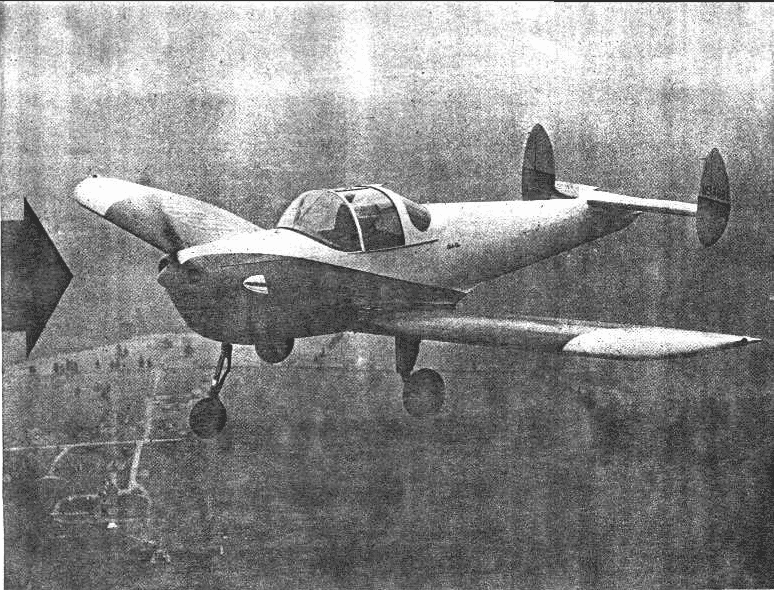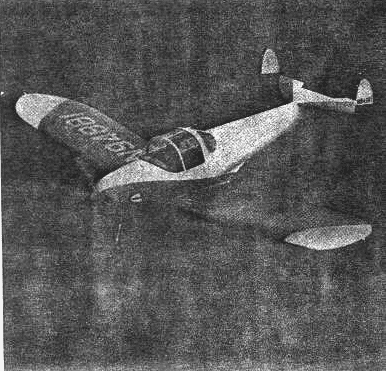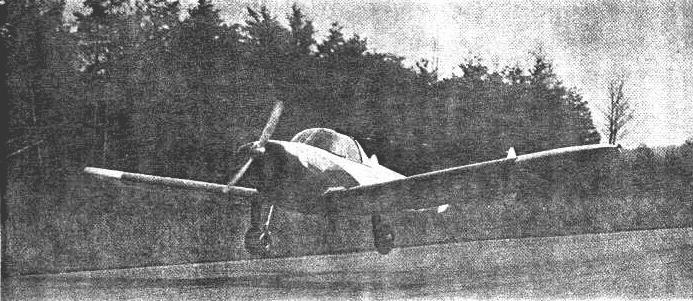Pilot's Report - NEW ERCOUPE part Two
The Ercoupe for 1950 is available in two versions: regular two-control model or the standard three-control
By A.H. Hasbrook
Upon completion of our ground tour, Redding turned us over to Bob Sanders, genial president and general manager of the Ercoupe sales organization, who was to be our demonstration co-pilot during the flight check of the 1950 two-control Ercoupe. While getting into the Club-Air, Sanders reported the airplane had a legal gross weight of 1400 pounds, including two persons, 75 pounds of baggage (or a small child in the jump seat) and full tanks (24 gallons) This tankage permits a bone dry no wind range of 430 miles at 110 mph , or 530 miles at 80 mph.

FEATURE of the new Ercoupe is an appealing paint job. The Club-Air, either two- or three-control models, is available in a two-tone green. In near future, there will be red-and-green combination.
The electric starter is engaged easily by means of a 'pull' handle located near the bottom of the instrument panel. After a brief warm-up period, we found that taxiing this new Ercoupe is a pleasure. Except at very low speeds, wheel pressures required for turning are light, almost like an automobile. However this case of steering combined with the excellent visibility over the nose and the sides tends to induce excessive taxiing speeds. The disk-type brakes, operated by a single foot pedal a, are very effective and, because of the tricycle gear, can be applied as heavily as desired.
After a routine engine check at the end of the 1500foot paved strip, a take-off was made into a crosswind of approximately 15 to 20 mph. Humidity was high and the temperature was low ' a wet , chilly day with not much lift in the air. We were nine gallons light and carrying no baggage, so became airborne about one third of the way down the strip. During this and subsequent take-offs, we made no attempt to 'horse' the plane off, desiring rather to let it get off in a manner most likely to be followed by the average pilot.
Too, we followed Sanders suggestions and kept the nose wheel definitely on the ground to maintain 'steerability' in the cross wind until we had sufficient speed (above 50 mph) to stay aloft once it was pulled off the runway. We believe the published gross weight take-off figures of 570 feet in no wind and with standard air are quite accurate, of course depending on pilot ability.
From a standing start, the ship was off the ground in about 12 seconds, One minute and 58 seconds later we were at an altitude of 1.000 feet , which works out to just slightly better than 500fpm rate of climb at the recommended best climb speed of 65 to 70 mph, at 2175 rpm (full throttle).
CRUISING SPEED of the Club-Air is between 110 and 113 mph at 2400 rpm at 2.000 feet. Author got an easy 110.

Climb to 2.000 feet was better, being around 550 fpm. However, along with the air being sub-standard, there were numerous gusts which decreased climb efficiency and made it almost impossible to check the rate of climb accurately. Too, the airplane we were flying was equipped with a MET-L cruising prop. Published performance figures indicate 560 fpm and we'll settle for this as being correct. At the 2400 rpm cruise recommended by Sanders, the airspeed indicated between 110 and 113 mph at 2.000 feet. Even though we could not check this because of rain in the timing course area, we're inclined to agree with the 110 mph cruise given on the performance data sheet. The additional 3 mph was possible due to a 'high reading' airspeed indicator but we are more inclined to think it was the result of the cruising prop. At this speed and rpm the ship maintained altitude with a slightly nose low attitude and there was noticeable lack of vibration. It was interesting to note that full throttle and with full back trim but with no manual force or aft pressure applied to the wheel, the airplane maintained 60mph, a speed well above stall.
Although application of a noticeable amount of back pressure (into the spring loaded range) reduced the speed to 50 mph, the Ercoupe still continued to climb. As we applied more back pressure, to a full back position, the nose assumed an attitude of about 35'. As the speed dropped to an indicated 45 mph, the ship stalled and started decisive roll toward the right, probably due to the induced aileron drag. However, while still holding the wheel all the way back, we found it possible to level the wings by rolling the wheel to the left. After picking up speed again, we pulled the Ercoupe into an abrupt 'whip stall' attitude. When the stall occurred in this extreme attitude, the nose dropped down straight away without any tendency towards yaw or roll. Breaking the stall was quite simple, just a slight release of back pressure and we were flying again. Checking minimum speed and power needed to maintain altitude, we found the Club-Air would hang on at 55mph, with 1550 to 1575 rpm, and lateral control was quite responsive. Not having a power load curve available, we wouldn't hazard a guess as to the power output at this rpm but it does indicate the ship can be kept aloft quite a long time while looking for a suitable forced landing spot in the event of a partial power failure. Next we checked the power-off rate of descent at safe minimum flight speed (sufficient for full lateral control) At an Indicated 50 mph in fairly gusty air, the ship descended between 500 and 700 fpm for an average of 10 feet per second. Thinking of night forced landings over unknown terrain; we asked Sanders whether the gear could withstand the impact load imposed by a landing from such a descent. His affirmative answer was based on reports of Ercoupes landing under similar emergency conditions without damage. Actually, it probably isn't important whether the gear gives way or not, so long as the rest of the airplane stays together and we feel quite sure it would.
With power-off stall characteristics next on our check list, we pulled throttle and eased back to the spring loaded 'cushion'. Considerable pressure was required to hold the wheel in a full aft position. As the speed dropped slowly past the 50 mph mark and hit 45, there was a light indication of stall and the nose rocked slowly downward to a position somewhat below the horizon, then started upward again. During this mild oscillation, the wheel was kept full back but lateral control remained excellent throughout the maneuver. Because of this mildness and sureness of control, the high rate of decent resulting from such a maneuver goes unsuspected for quite a while. Too, quite a bit of altitude is lost when the nose is dropped in recovery. This may account for the reason some Ercoupes have landed abruptly and short of the runway after being brought in at too slow an approach speed.
The last maneuver checked in the two control model was a power-on stall in a steeply banked turn. Maintaining altitude, we finally obtained about 70' bank- it appeared to be almost vertical. After about three complete turns, the airplane stalled with the wheel all the way back. As it did, the ship whipped over to an opposite bank of about 35' but unstalled itself during the partial roll. Although this might be somewhat breathtaking to a student, it did not appear to us to be particularly dangerous, and we lost no altitude.
On the downwind leg of the pattern we throttled back and set the trim full back, an easy operation accomplished with one hand. With very little pressure on the wheel 65 mph was maintained until just over the boundary of the field. At that point we began our flare-out but forgot about the spring-loaded 'cushion' and failed to get the wheel full back, consequently touching down on all three wheels at practically the same moment. On the next landing, made intentionally almost due to crosswind with gusts up to 30 mph, we touched the main gear on first and then had to be reminded by Sanders to release the wheel so the nose gear could take hold and maintain a straight path down the runway. We're sure a person learning to fly on a two-control Ercoupe would have no difficulty acquiring this landing technique.
PILOT-AUTHOR Hasbrook came in over field boundary at 65 mph, then at that point began his flare-out, wheel way back.

| Back to part One | Continue to part Three |